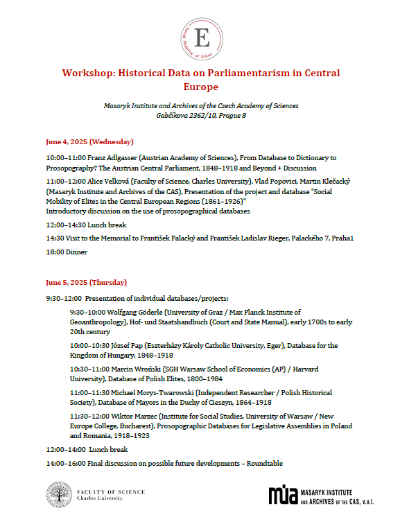
Our project focuses on the category of drafting officials (“Konzeptsbeamte”) employed in state internal administration. These clerks were civil servants with significant decision-making powers in the exercise of state administration. Only candidates with university education could join these ranks, and these were mostly recruited from graduates of law faculties of Austrian universities. Only this type of education enabled a young clerk to progress on the career ladder and reach senior positions with the accompanying influence, social prestige and material well-being.
In both the Cisleithanian and Czechoslovak public administration, the state internal administration (so called political administration) represented the most important component, a backbone linking together all the other, specialized administrative branches – chiefly the police, schools, the postal service, but partly also the administration of churches, post offices, the mining authorities or the justice system. Political offices also played a key role in communication with local administrative units – municipalities and their mayors, district councils or the land committee. The task of political administration was not only to guarantee proper exercise of internal administration throughout the country, but also to monitor the compliance with applicable law and the implementation of newly adopted government measures. For this purpose, a relatively dense network of first-instance offices was in place – district captainships, called district political administrative offices, after 1918, i.e. district offices headed by district captains. The captainships were subject to offices of the second instance (Governor’s Offices or Land Governments, after 1918 Land political administration, or Land offices. At the top of this administrative hierarchy was the Ministry of the Interior.
For the purposes of our project we considered as members of the administrative elites those officials who attained a career rank which enabled them to run independently a district office or manage one of the departments of the Land office. In the Austrian system comprising twelve career ranks (the XI being the lowest, and I the highest, e.g. that of the prime minister) he had to attain at least rank VIII. Consequently. We only deal with those drafting clerks in Bohemia who in 1868-1918 attained rank VIII and the position of senior governor´s office official or chief district commissioner. With this rank they could become administrators of one of the district captainships (and later be promoted to the post of district captain), or work as deputies to heads of the individual departments on the land level. We also included in our sample holders of offices closely linked with political administration – the Director of Police Headquarters in Prague as well as officials within the Land School Board (e.g. land school inspectors).
Given that after 1918 there were several waves of mass promotion, which was no longer linked to being transferred to a senior position and which led to a less strict correspondence between the rank achieved and the position held, we take into account only those officials holding the top positions of chiefs of district political administrations and heads of departments of the Land political administration.
|
Career rank |
Position 1873-1918 |
Position 1919-1926 |
|
XI. |
Statthalterei-Konzeptspraktikant (Trainee Official) |
Konzipient der politischen Verwaltung (Trainee Official) |
|
X. |
Statthalterei-Konzipist (Junior Governor’s Office Official) |
Konzipist der politischen Verwaltung (Official of political Administration) |
|
IX. |
Bezirkskommissar (District Commissioner) |
Bezirkskommissar (District Commissioner) |
|
VIII. |
Statthalterei-Sekretär (Senior Governor’s Office Official) Bezirksoberkommissar (Chief District Commissioner) |
Bezirksoberkommissar (Chief District Commissioner) |
|
VII. |
Bezirkshauptmann (District Captain) |
Bezirkshauptmann (District Captain) |
|
VI. |
Statthaltereirat (Junior Governor’s Office Councillor) |
Rat der politischen Verwaltung (Councillor of political Administration) |
|
V. |
Hofrat (Senior Governor’s Office Councillor) |
Ministerialrat (Ministerial Councillor) Regierungsrat (Governmental Councillor) |
|
IV. |
Statthaltereivizepräsident (Deputy Governor) |
Vizepräsident der politischen Verwaltung (Vice President of political Administration) |
|
III. |
Statthalter (Governor) |
Präsident der politischen Verwaltung (President of political Administration) |
To find these individuals we chiefly used the Lexicon of members of political administration in Bohemia (Prague 2020) as well as the regularly published records of the clerical staff of the political administration, or directly the archives of the Presidium of the Governor’s Office, Presidium of the Land Office and Presidium of the Interior Ministry, deposited in the National Archives in Prague.
To learn about the careers of the individual officials as thoroughly as possible is crucial for us not only in order to evaluate their professional career and its possible linkages to personal and family life, but also to reconstruct the relational networks. State officials were among the most mobile population groups, doubly so officials with university education. It was in the state´s interest that its employees who were to be entrusted with decisions on matters of internal administration acquire the widest possible experience and gain a broad perspective in all administrative agendas. This is why in the first years of service concept clerks were regularly transferred within the territory, which complicates the search for data on their marriage (unlike army officials, state officials did not need to ask for approval to get married) as well as the search for all their offspring born into marriage.
In contrast to the clearly given numbers of deputy seats we are not yet able to determine the final number of administrative officials who will enter our sample. Given that from 1868 onwards, the number of districts in Bohemia rose steadily (from the original 79 to 102 in 1918), along with the increasing numbers of officials working in the Land headquarters in Prague, we suppose that most of the individuals in our sample will be from the youngest cohorts born after 1861.

